Object Oriented Programming: Model Design, Implementation & Report
VerifiedAdded on 2023/05/28
|10
|1290
|232
Project
AI Summary
This project implements object-oriented programming paradigms, focusing on reusability within a programming software system. Key concepts such as inheritance, generics, composition, and polymorphism are utilized to design class patterns within an object-oriented system. The project emphasizes the importance of reusable components and provides system documentation describing implementation factors that facilitate reuse and maintenance. It investigates the design aspects of object-oriented programming languages, particularly concerning classes, interfaces, and abstract classes. The report includes examples and explanations of objects, inheritance (including superclasses and subclasses), composition, polymorphism, and generics. It also touches on object-oriented system design and the benefits of using visual modeling for effective stakeholder communication and improved product quality. The project successfully demonstrates the application of object-oriented principles to achieve software reusability and maintainability.
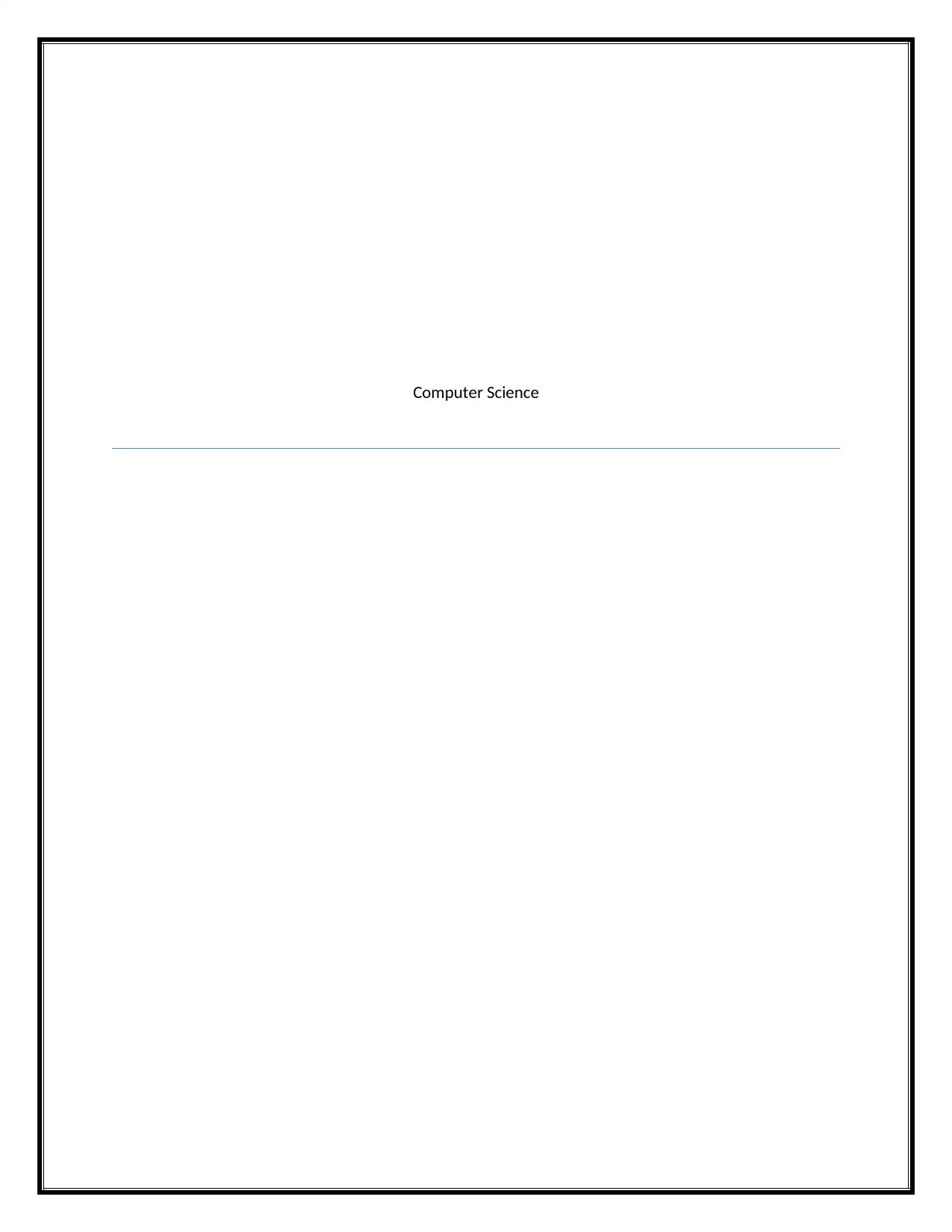
Computer Science
Paraphrase This Document
Need a fresh take? Get an instant paraphrase of this document with our AI Paraphraser
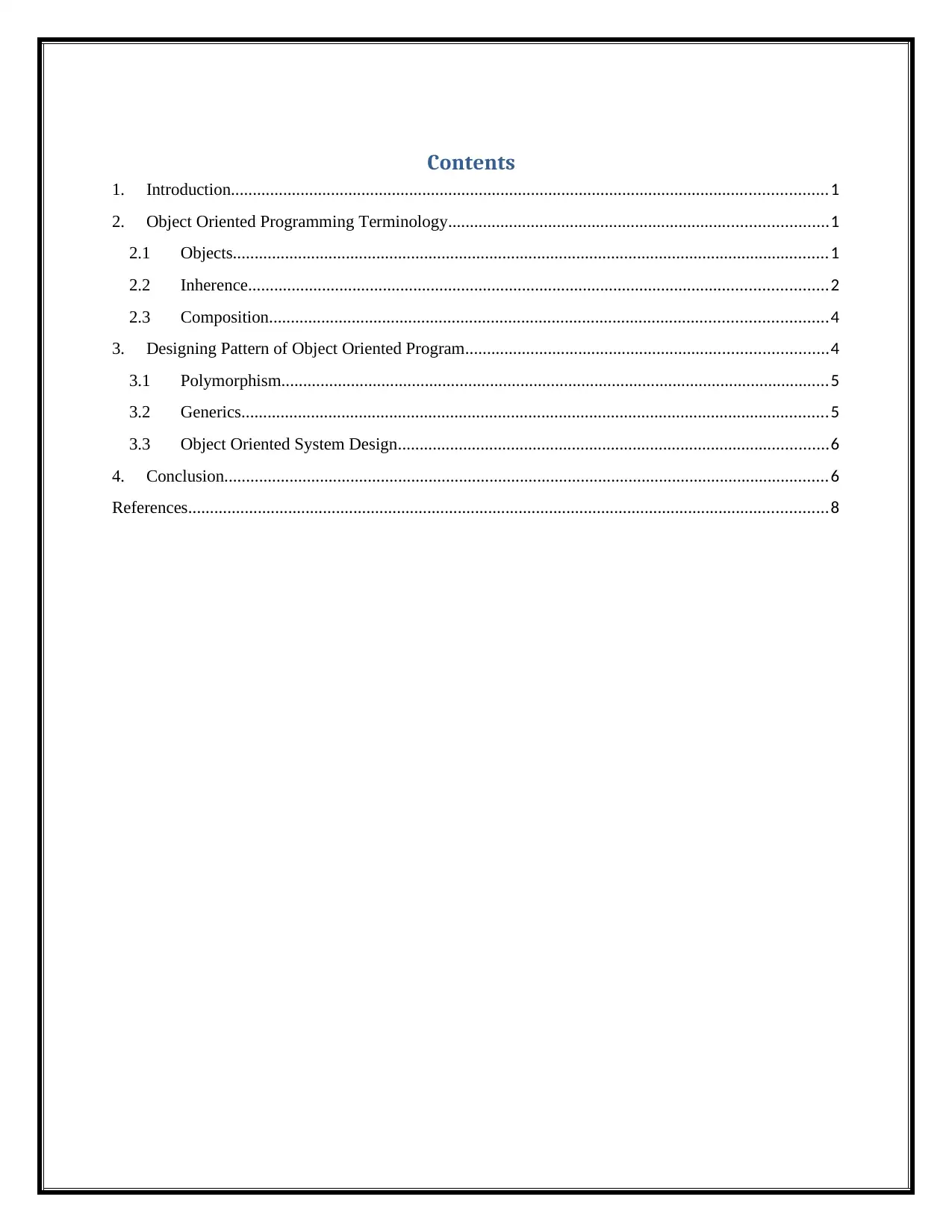
Contents
1. Introduction.........................................................................................................................................1
2. Object Oriented Programming Terminology.......................................................................................1
2.1 Objects.........................................................................................................................................1
2.2 Inherence.....................................................................................................................................2
2.3 Composition................................................................................................................................4
3. Designing Pattern of Object Oriented Program...................................................................................4
3.1 Polymorphism..............................................................................................................................5
3.2 Generics.......................................................................................................................................5
3.3 Object Oriented System Design...................................................................................................6
4. Conclusion...........................................................................................................................................6
References...................................................................................................................................................8
1. Introduction.........................................................................................................................................1
2. Object Oriented Programming Terminology.......................................................................................1
2.1 Objects.........................................................................................................................................1
2.2 Inherence.....................................................................................................................................2
2.3 Composition................................................................................................................................4
3. Designing Pattern of Object Oriented Program...................................................................................4
3.1 Polymorphism..............................................................................................................................5
3.2 Generics.......................................................................................................................................5
3.3 Object Oriented System Design...................................................................................................6
4. Conclusion...........................................................................................................................................6
References...................................................................................................................................................8
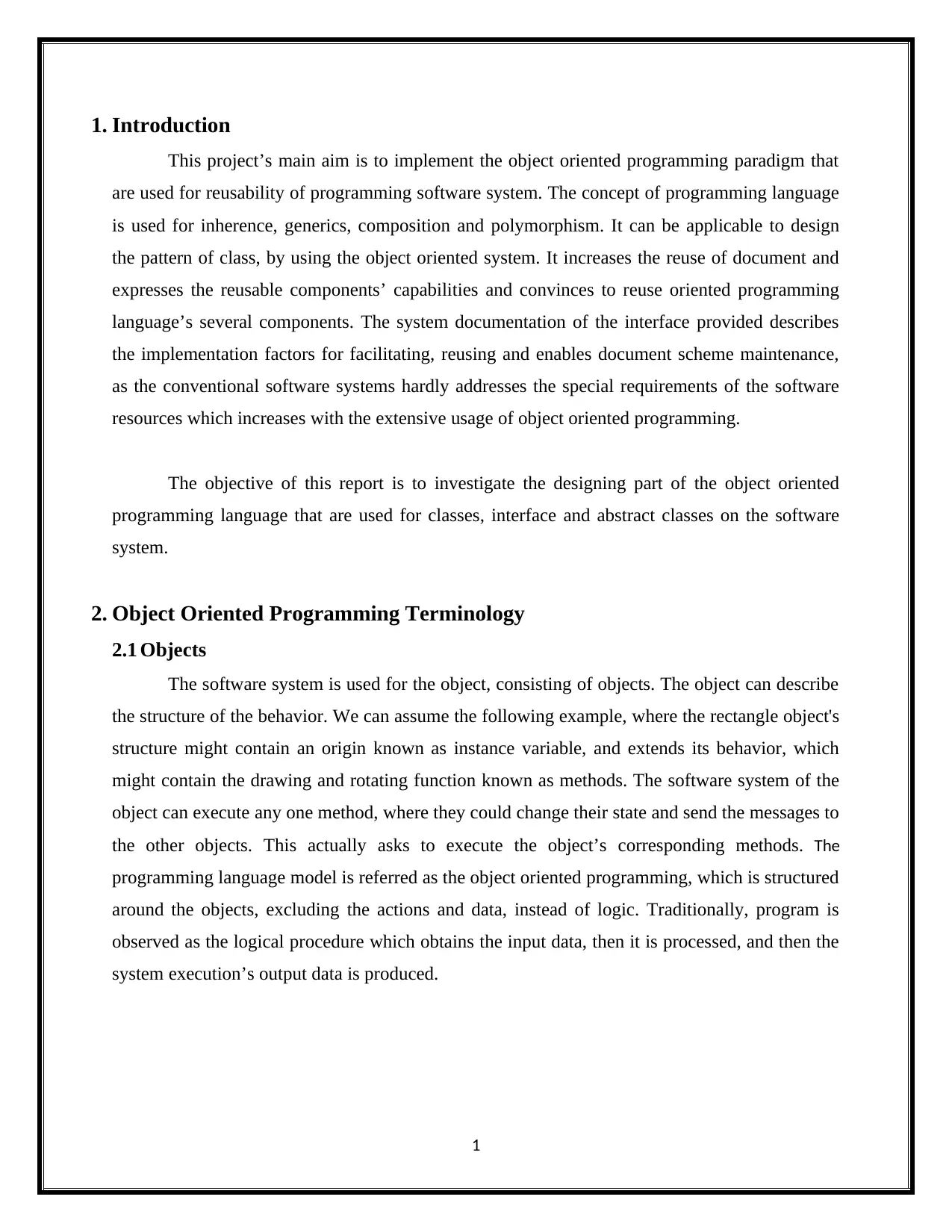
1. Introduction
This project’s main aim is to implement the object oriented programming paradigm that
are used for reusability of programming software system. The concept of programming language
is used for inherence, generics, composition and polymorphism. It can be applicable to design
the pattern of class, by using the object oriented system. It increases the reuse of document and
expresses the reusable components’ capabilities and convinces to reuse oriented programming
language’s several components. The system documentation of the interface provided describes
the implementation factors for facilitating, reusing and enables document scheme maintenance,
as the conventional software systems hardly addresses the special requirements of the software
resources which increases with the extensive usage of object oriented programming.
The objective of this report is to investigate the designing part of the object oriented
programming language that are used for classes, interface and abstract classes on the software
system.
2. Object Oriented Programming Terminology
2.1 Objects
The software system is used for the object, consisting of objects. The object can describe
the structure of the behavior. We can assume the following example, where the rectangle object's
structure might contain an origin known as instance variable, and extends its behavior, which
might contain the drawing and rotating function known as methods. The software system of the
object can execute any one method, where they could change their state and send the messages to
the other objects. This actually asks to execute the object’s corresponding methods. The
programming language model is referred as the object oriented programming, which is structured
around the objects, excluding the actions and data, instead of logic. Traditionally, program is
observed as the logical procedure which obtains the input data, then it is processed, and then the
system execution’s output data is produced.
1
This project’s main aim is to implement the object oriented programming paradigm that
are used for reusability of programming software system. The concept of programming language
is used for inherence, generics, composition and polymorphism. It can be applicable to design
the pattern of class, by using the object oriented system. It increases the reuse of document and
expresses the reusable components’ capabilities and convinces to reuse oriented programming
language’s several components. The system documentation of the interface provided describes
the implementation factors for facilitating, reusing and enables document scheme maintenance,
as the conventional software systems hardly addresses the special requirements of the software
resources which increases with the extensive usage of object oriented programming.
The objective of this report is to investigate the designing part of the object oriented
programming language that are used for classes, interface and abstract classes on the software
system.
2. Object Oriented Programming Terminology
2.1 Objects
The software system is used for the object, consisting of objects. The object can describe
the structure of the behavior. We can assume the following example, where the rectangle object's
structure might contain an origin known as instance variable, and extends its behavior, which
might contain the drawing and rotating function known as methods. The software system of the
object can execute any one method, where they could change their state and send the messages to
the other objects. This actually asks to execute the object’s corresponding methods. The
programming language model is referred as the object oriented programming, which is structured
around the objects, excluding the actions and data, instead of logic. Traditionally, program is
observed as the logical procedure which obtains the input data, then it is processed, and then the
system execution’s output data is produced.
1
⊘ This is a preview!⊘
Do you want full access?
Subscribe today to unlock all pages.

Trusted by 1+ million students worldwide
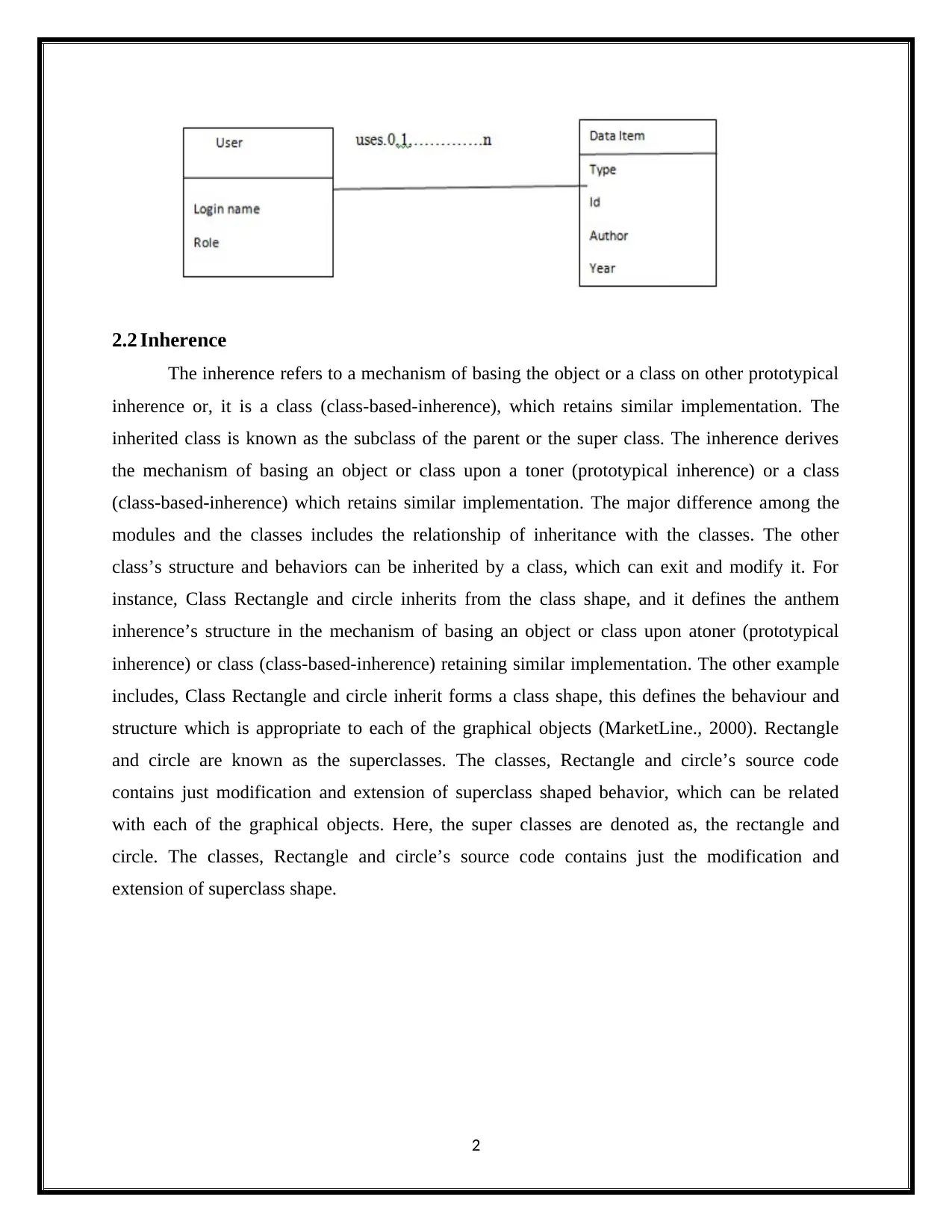
2.2 Inherence
The inherence refers to a mechanism of basing the object or a class on other prototypical
inherence or, it is a class (class-based-inherence), which retains similar implementation. The
inherited class is known as the subclass of the parent or the super class. The inherence derives
the mechanism of basing an object or class upon a toner (prototypical inherence) or a class
(class-based-inherence) which retains similar implementation. The major difference among the
modules and the classes includes the relationship of inheritance with the classes. The other
class’s structure and behaviors can be inherited by a class, which can exit and modify it. For
instance, Class Rectangle and circle inherits from the class shape, and it defines the anthem
inherence’s structure in the mechanism of basing an object or class upon atoner (prototypical
inherence) or class (class-based-inherence) retaining similar implementation. The other example
includes, Class Rectangle and circle inherit forms a class shape, this defines the behaviour and
structure which is appropriate to each of the graphical objects (MarketLine., 2000). Rectangle
and circle are known as the superclasses. The classes, Rectangle and circle’s source code
contains just modification and extension of superclass shaped behavior, which can be related
with each of the graphical objects. Here, the super classes are denoted as, the rectangle and
circle. The classes, Rectangle and circle’s source code contains just the modification and
extension of superclass shape.
2
The inherence refers to a mechanism of basing the object or a class on other prototypical
inherence or, it is a class (class-based-inherence), which retains similar implementation. The
inherited class is known as the subclass of the parent or the super class. The inherence derives
the mechanism of basing an object or class upon a toner (prototypical inherence) or a class
(class-based-inherence) which retains similar implementation. The major difference among the
modules and the classes includes the relationship of inheritance with the classes. The other
class’s structure and behaviors can be inherited by a class, which can exit and modify it. For
instance, Class Rectangle and circle inherits from the class shape, and it defines the anthem
inherence’s structure in the mechanism of basing an object or class upon atoner (prototypical
inherence) or class (class-based-inherence) retaining similar implementation. The other example
includes, Class Rectangle and circle inherit forms a class shape, this defines the behaviour and
structure which is appropriate to each of the graphical objects (MarketLine., 2000). Rectangle
and circle are known as the superclasses. The classes, Rectangle and circle’s source code
contains just modification and extension of superclass shaped behavior, which can be related
with each of the graphical objects. Here, the super classes are denoted as, the rectangle and
circle. The classes, Rectangle and circle’s source code contains just the modification and
extension of superclass shape.
2
Paraphrase This Document
Need a fresh take? Get an instant paraphrase of this document with our AI Paraphraser
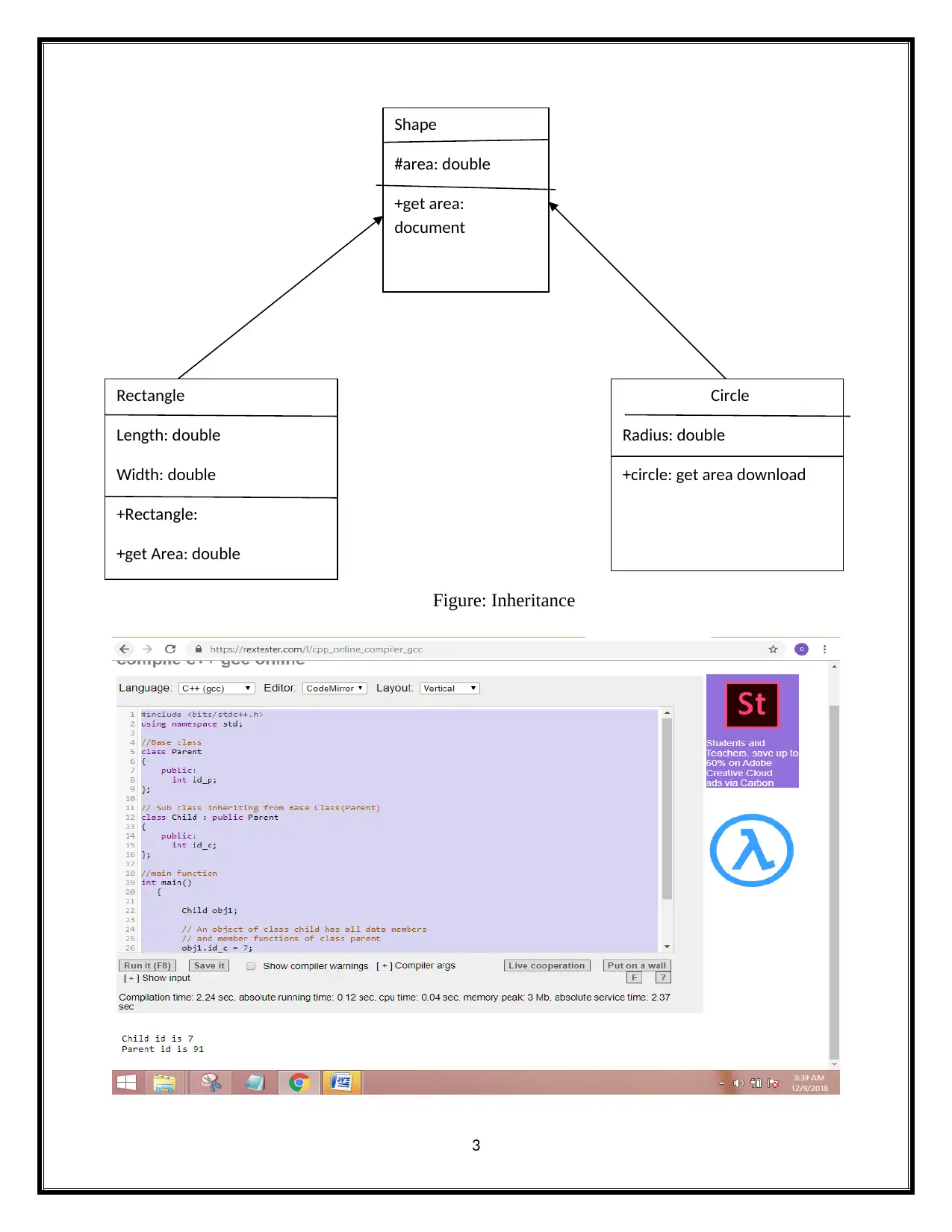
Figure: Inheritance
3
Shape
#area: double
+get area:
document
Rectangle
Length: double
Width: double
+Rectangle:
+get Area: double
Circle
Radius: double
+circle: get area download
3
Shape
#area: double
+get area:
document
Rectangle
Length: double
Width: double
+Rectangle:
+get Area: double
Circle
Radius: double
+circle: get area download
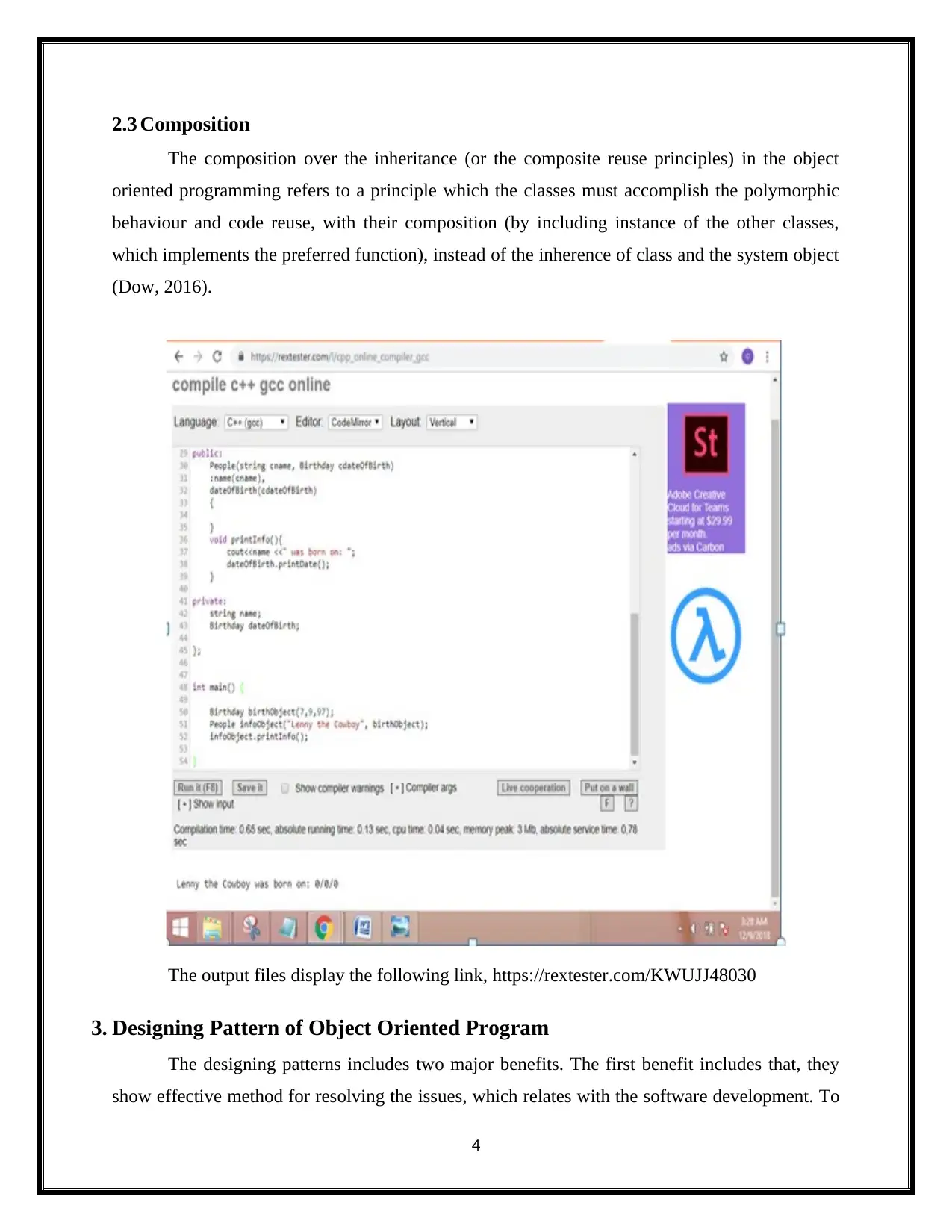
2.3 Composition
The composition over the inheritance (or the composite reuse principles) in the object
oriented programming refers to a principle which the classes must accomplish the polymorphic
behaviour and code reuse, with their composition (by including instance of the other classes,
which implements the preferred function), instead of the inherence of class and the system object
(Dow, 2016).
The output files display the following link, https://rextester.com/KWUJJ48030
3. Designing Pattern of Object Oriented Program
The designing patterns includes two major benefits. The first benefit includes that, they
show effective method for resolving the issues, which relates with the software development. To
4
The composition over the inheritance (or the composite reuse principles) in the object
oriented programming refers to a principle which the classes must accomplish the polymorphic
behaviour and code reuse, with their composition (by including instance of the other classes,
which implements the preferred function), instead of the inherence of class and the system object
(Dow, 2016).
The output files display the following link, https://rextester.com/KWUJJ48030
3. Designing Pattern of Object Oriented Program
The designing patterns includes two major benefits. The first benefit includes that, they
show effective method for resolving the issues, which relates with the software development. To
4
⊘ This is a preview!⊘
Do you want full access?
Subscribe today to unlock all pages.

Trusted by 1+ million students worldwide
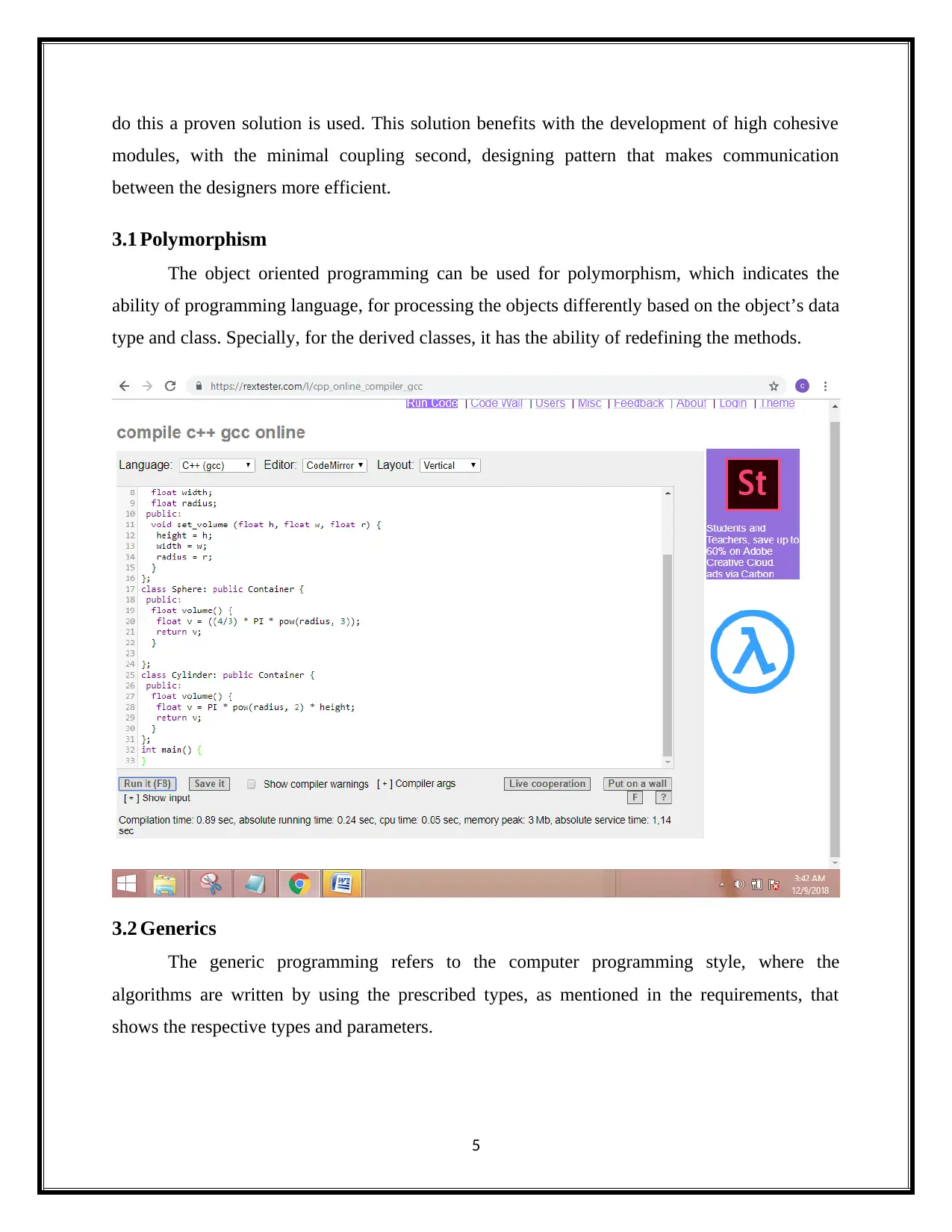
do this a proven solution is used. This solution benefits with the development of high cohesive
modules, with the minimal coupling second, designing pattern that makes communication
between the designers more efficient.
3.1 Polymorphism
The object oriented programming can be used for polymorphism, which indicates the
ability of programming language, for processing the objects differently based on the object’s data
type and class. Specially, for the derived classes, it has the ability of redefining the methods.
3.2 Generics
The generic programming refers to the computer programming style, where the
algorithms are written by using the prescribed types, as mentioned in the requirements, that
shows the respective types and parameters.
5
modules, with the minimal coupling second, designing pattern that makes communication
between the designers more efficient.
3.1 Polymorphism
The object oriented programming can be used for polymorphism, which indicates the
ability of programming language, for processing the objects differently based on the object’s data
type and class. Specially, for the derived classes, it has the ability of redefining the methods.
3.2 Generics
The generic programming refers to the computer programming style, where the
algorithms are written by using the prescribed types, as mentioned in the requirements, that
shows the respective types and parameters.
5
Paraphrase This Document
Need a fresh take? Get an instant paraphrase of this document with our AI Paraphraser
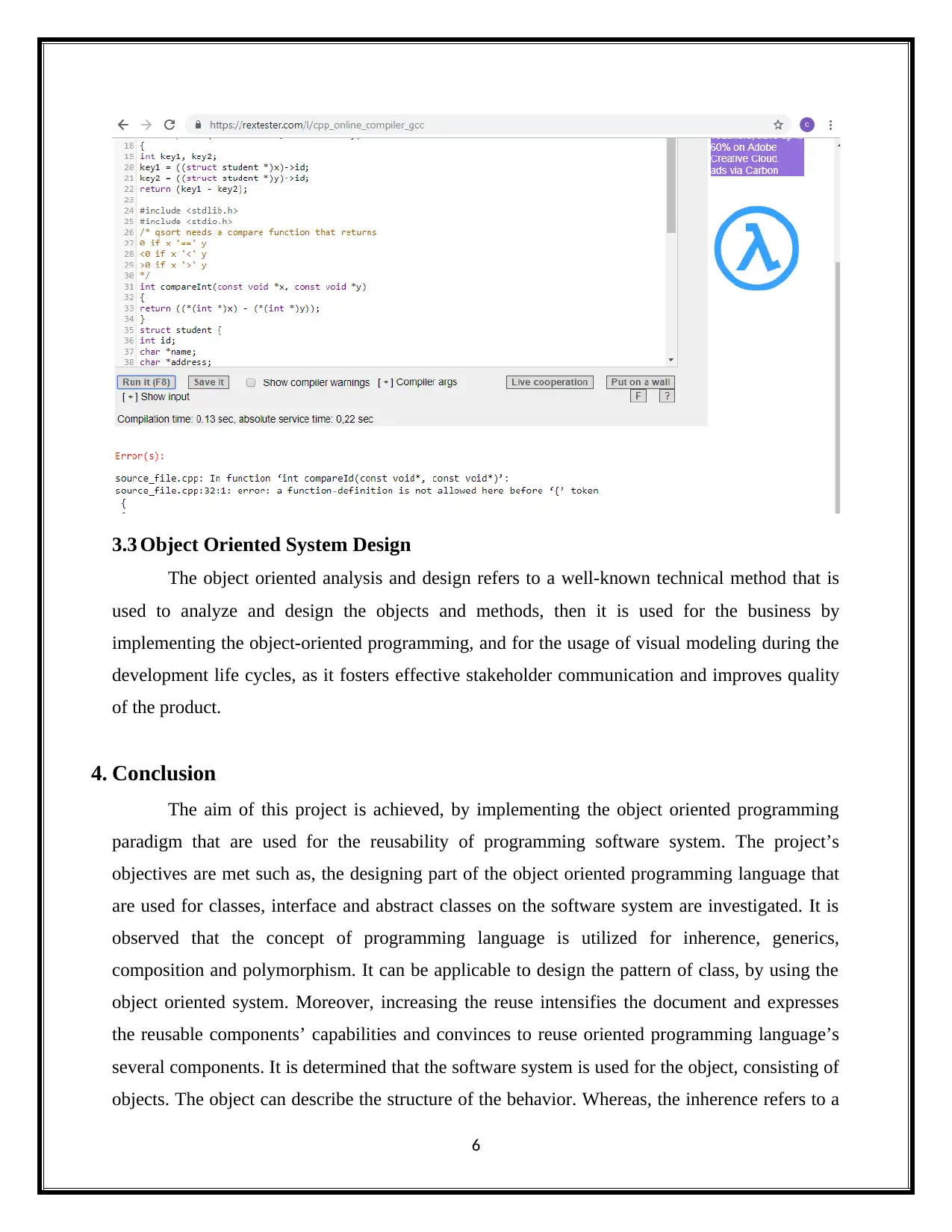
3.3 Object Oriented System Design
The object oriented analysis and design refers to a well-known technical method that is
used to analyze and design the objects and methods, then it is used for the business by
implementing the object-oriented programming, and for the usage of visual modeling during the
development life cycles, as it fosters effective stakeholder communication and improves quality
of the product.
4. Conclusion
The aim of this project is achieved, by implementing the object oriented programming
paradigm that are used for the reusability of programming software system. The project’s
objectives are met such as, the designing part of the object oriented programming language that
are used for classes, interface and abstract classes on the software system are investigated. It is
observed that the concept of programming language is utilized for inherence, generics,
composition and polymorphism. It can be applicable to design the pattern of class, by using the
object oriented system. Moreover, increasing the reuse intensifies the document and expresses
the reusable components’ capabilities and convinces to reuse oriented programming language’s
several components. It is determined that the software system is used for the object, consisting of
objects. The object can describe the structure of the behavior. Whereas, the inherence refers to a
6
The object oriented analysis and design refers to a well-known technical method that is
used to analyze and design the objects and methods, then it is used for the business by
implementing the object-oriented programming, and for the usage of visual modeling during the
development life cycles, as it fosters effective stakeholder communication and improves quality
of the product.
4. Conclusion
The aim of this project is achieved, by implementing the object oriented programming
paradigm that are used for the reusability of programming software system. The project’s
objectives are met such as, the designing part of the object oriented programming language that
are used for classes, interface and abstract classes on the software system are investigated. It is
observed that the concept of programming language is utilized for inherence, generics,
composition and polymorphism. It can be applicable to design the pattern of class, by using the
object oriented system. Moreover, increasing the reuse intensifies the document and expresses
the reusable components’ capabilities and convinces to reuse oriented programming language’s
several components. It is determined that the software system is used for the object, consisting of
objects. The object can describe the structure of the behavior. Whereas, the inherence refers to a
6
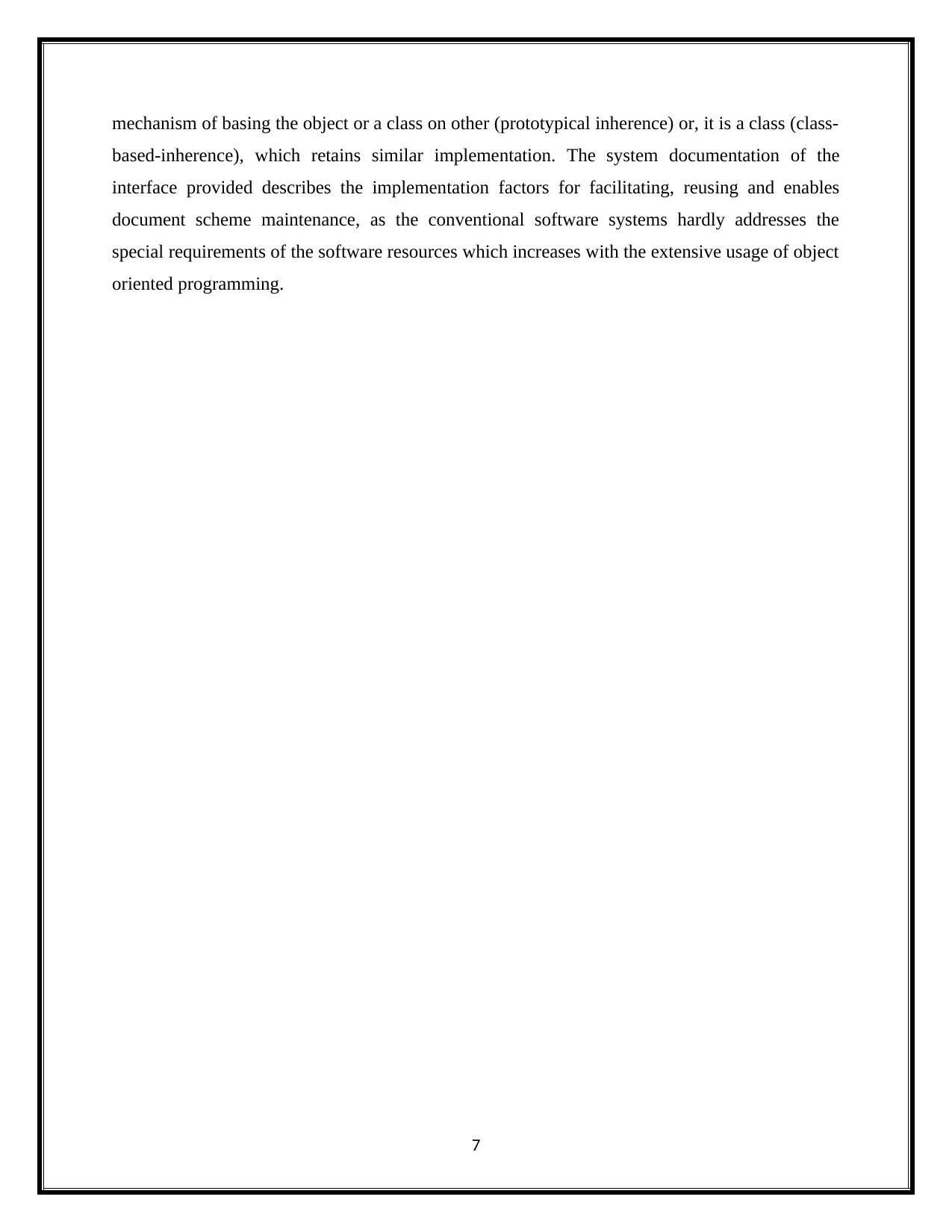
mechanism of basing the object or a class on other (prototypical inherence) or, it is a class (class-
based-inherence), which retains similar implementation. The system documentation of the
interface provided describes the implementation factors for facilitating, reusing and enables
document scheme maintenance, as the conventional software systems hardly addresses the
special requirements of the software resources which increases with the extensive usage of object
oriented programming.
7
based-inherence), which retains similar implementation. The system documentation of the
interface provided describes the implementation factors for facilitating, reusing and enables
document scheme maintenance, as the conventional software systems hardly addresses the
special requirements of the software resources which increases with the extensive usage of object
oriented programming.
7
⊘ This is a preview!⊘
Do you want full access?
Subscribe today to unlock all pages.

Trusted by 1+ million students worldwide
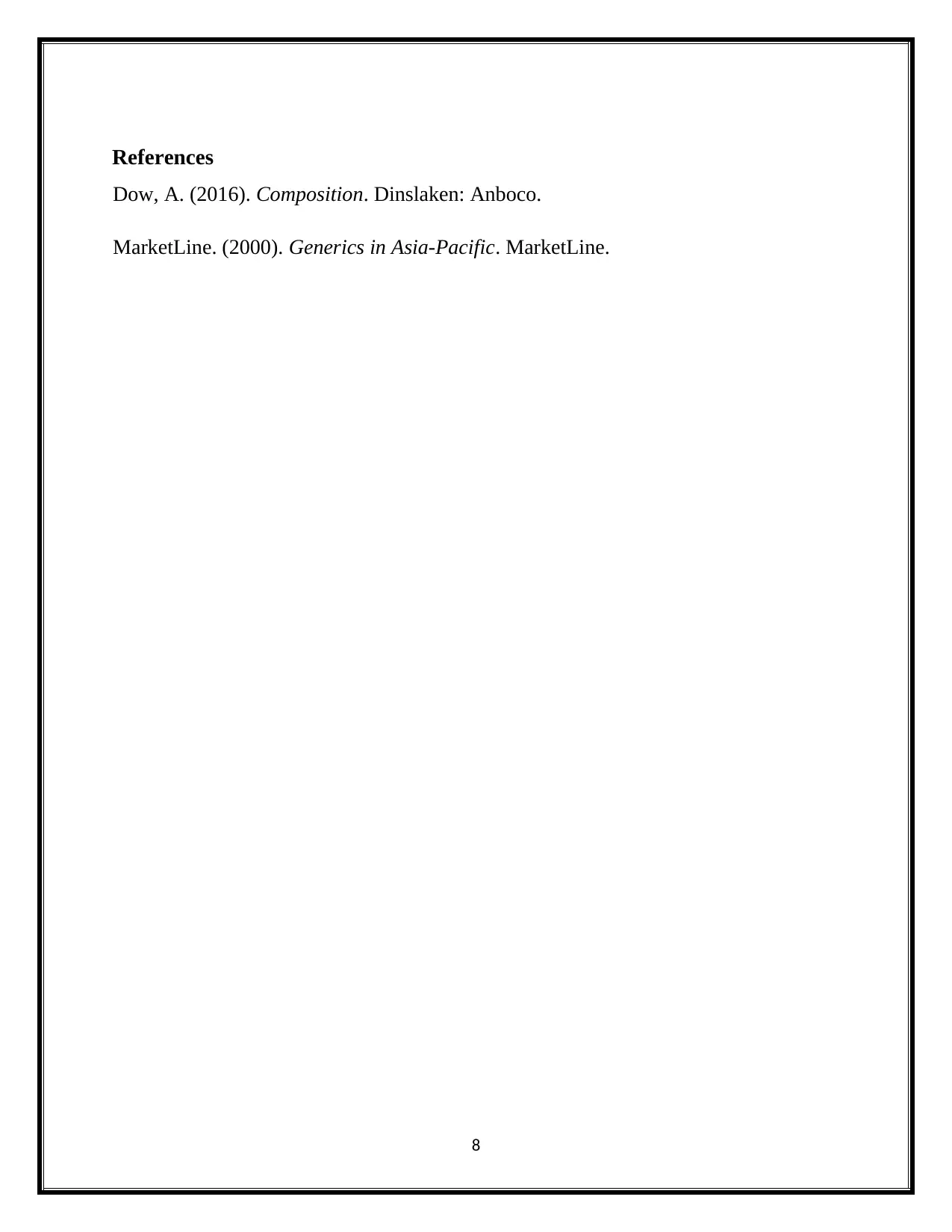
References
Dow, A. (2016). Composition. Dinslaken: Anboco.
MarketLine. (2000). Generics in Asia-Pacific. MarketLine.
8
Dow, A. (2016). Composition. Dinslaken: Anboco.
MarketLine. (2000). Generics in Asia-Pacific. MarketLine.
8
1 out of 10
Related Documents
Your All-in-One AI-Powered Toolkit for Academic Success.
+13062052269
info@desklib.com
Available 24*7 on WhatsApp / Email
![[object Object]](/_next/static/media/star-bottom.7253800d.svg)
Unlock your academic potential
Copyright © 2020–2025 A2Z Services. All Rights Reserved. Developed and managed by ZUCOL.


